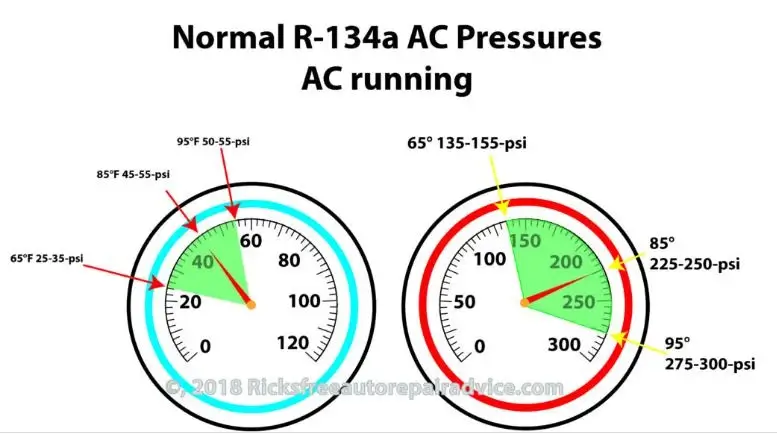I wouldn't be surprised to see 100PSI static on a 95F ambient temperature.
I'd be more happy to see 90PSI static as usually the tractor is going to be a bit less then ambient.
And 45-50 wouldn't be too high on a 95F ambient.
Here is a good article:
Normal Pressure Readings for R-134a Refrigerant Car AC Systems
As an automotive AC expert, I can tell you that knowing the normal pressure readings for a R-134a system is essential if you’re diagnosing a problem with your car’s air conditioning system. If you don’t know what the pressures should be, you can’t possibly determine whether your system is functioning properly, or whether you’ve got a problem that needs to be fixed.
When I’m checking an AC system, I always refer to a few critical conditions before evaluating whether the pressure readings are within the normal range. Here’s exactly what you need to do.
What Are the Conditions for Checking Car AC Normal Pressure Readings?
When you’re testing the AC system, it must be operating under these conditions for accurate readings
• The engine should be running at 1,500 RPM
• Air conditioning turned on and set to maximum
• The compressor clutch (if equipped) must be fully engaged
If you don’t meet these conditions, your car’s AC normal pressure readings won’t be valid.
Just as important, you must account for ambient temperature. AC pressures rise and fall in relation to the outside temperature, so any pressure reading is meaningless without that context.
My Rule of Thumb for Car AC Normal Pressure Readings (R-134a)
Over the years of working on AC systems, here’s the simple rule I rely on:
• In most typical conditions (70–85°F ambient temperatures), expect the low side to read in the 27–32 psi. range with the compressor engaged. This pressure corresponds to the refrigerant boiling at around
32°F to 40°F at the evaporator, which is necessary for proper cabin cooling without freezing the evaporator coil. However, the exact pressure will vary slightly based on:
• Ambient temperature
• The ambient humidity
• System load (fan speed, engine RPM)
As Ambient Temperature Increases— The low-side pressure may creep slightly higher—up to 45–55 psi—especially on very hot days (90°F to 105°F).
• The high side pressure is usually 2.2 to 2.5 times the ambient temperature (in °F). For example, if the ambient temperature is 90°F (32°C), the ideal high-side pressure should be around:
2.2 x 90 = 198 psi
2.5 x 90 = 225 psi
So, the target high-side pressure range would be 198-225 psi when the ambient temperature is 90°F (32°C).
Using this rule of thumb, you can quickly determine if your AC system’s low and high-side pressures are operating within normal ranges based on the current ambient temperature.
 Generally speaking, you want around 27-32 psi on the low side and 200 on the high side.
Generally speaking, you want around 27-32 psi on the low side and 200 on the high side.
Why is 27-psi the optimal pressure for the low side?
Because, on an R-134a AC system, a pressure of 27-psi. on your gauge means the refrigerant will produce about 32°F at the evaporator, as long as the orifice tube/expansion valve is operating properly and there’s no air in the system (air in the system can artificially inflate the pressure to 27-psi).
Car AC Normal Pressure Readings by Ambient Temperature
If you want a fast cheat sheet, this is the reference chart I personally use when diagnosing AC systems:
65°F Ambient temperature: Low side pressure 25-35 psi High side pressure 135-155 psi
70°F Ambient temperature: Low side pressure 35-40 psi High side pressure 145-160 psi
75°F Ambient temperature: Low side pressure 35-45 psi High side pressure 150-170 psi
80°F Ambient temperature: Low side pressure 40-50 psi High side pressure 175-210 psi
85°F Ambient temperature: Low side pressure 45-55 psi High side pressure 225-250 psi
90°F Ambient temperature: Low side pressure 45-55 psi High side pressure 250-270 psi
95°F Ambient temperature: Low side pressure 50.55 psi High side pressure 275.300 psi
100°F Low side pressure 50-55 psi High side pressure 315-325 psi
105°F Ambient temperature: Low side pressure 50-55 psi High side pressure 330-335 psi
110°F Ambient temperature: Low side pressure 50.55 psi High side pressure 340.345 psi
Quick Tip:
If the high side is running higher than this, check the airflow over the condenser first. Blocked condensers are one of the most common causes of pressure issues that fall outside car AC normal pressure readings.
What If Your Pressures Don’t Match This Chart?
When the car AC normal pressure readings are out of range, that’s a clear red flag. It could mean:
• Low refrigerant (low pressures both sides)
• Overcharged system (high pressures both sides)
• Bad compressor (low high-side pressure)
• Clogged orifice tube/expansion valve (low low-side, high high-side)
• Condenser airflow restriction (high high-side pressure)
I highly recommend checking out my full guide on diagnosing abnormal AC pressure readings to pinpoint the issue quickly.See
this article on abnormal pressure readings and the most common causes.
© 2019 Rick Muscoplat
Posted on
April 4, 2024 by
Rick Muscoplat